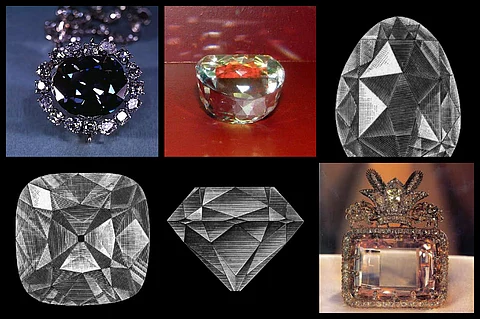

Bringing the Koh-i-noor fable back on to the table, just a few days after sparking a debate, the External Affairs Ministry on Friday reiterated that it would “amicably” bring the much-awaited diamond back from Britain. While the ‘mountain of light’ is a 5000-year-old pride of Kolluru, Koh-i-noor is not the only diamond that left the shores of India. Legend has it that the Golconda citadel of Andhra Pradesh is known for housing 8 other diamonds.
Hope diamond:
Known to be from the mines of Kolluru in Golconda, this purplish blue diamond was owned by French merchant traveller, Jean Baptiste Tavernier in the 1660s. It is unclear as to how the merchant got the diamond, but according to the Smithsonian, Tavernier purchased the 112 3/16 carat diamond who then sold it to French King Louis XIV of France. Going through a lot of hands, the ‘French Blue’ was finally donated to the Smithsonian Institution in Washington DC, on November 10, 1958. Since then, the now 45.5 carat diamond has left the museum only 4 times, for exhibitions.
Daria-i-Noor:
Often dubbed the sister diamond of Kohinoor, Daria-i-Noor is also said to have its roots from the Golconda mines, before it was acquired by a succession of Maratha kings and Shahs of Persia. Like the Kohinoor, Daria-i-Noor (Ocean of light) was then acquired by Maharaja Ranjit Singh, after which it was taken over by the East India Company. The now 182 carat diamond is now said to be part of the Iranian crown jewels, according to retired Professor of Geology V. Madhavan of the Kakatiya University, published in The Hindu.
Noor-ul-Ain:
Believed to be one of the largest pink diamonds in the world, is said to have been brought along with Daria-i-Noor, from the Golconda mines. The 60 carat diamond now sits part of the Iranian crown jewels like the former.
Hortensia diamond:
Said to be purchased by King Louis XIV of France between 1643 and 1715, with its origins lying in the Golconda mines, the 20 carat pentagonal diamond is now part of the French crown jewels. The diamond was allegedly stolen twice, once during the French revolution and the second time, from the Ministry of Marine. Today the diamond is exhibited at the Galerie d’Apollon of the Louvre museum in Paris.
Regent diamond:
Discovered in the Golconda mines in 1698, the stone appealed to the interest of Thomas Pitt, English Governor of Madras, according to Louvre. Known for its finest cut, it was then purchased for the French crown in 1717 by Regent Philippe d'Orléans. Weighing 426 carat before being cut, the diamond is now 140.6 carat and is now exhibited at the Louvre museum in Paris along with the Hortensia diamond. Considered to be one of the finest diamonds discovered, Regent is of the colour “of the first water”, which is said to be a perfect white.
Sancy diamond:
Known to be the sibling diamonds of Regent and Hortensia, the Sancy diamond weighs 55.232 carat, which is surrounded by white gold, in the Paris crown jewels, exhibited at the Louvre museum in Paris. Believed to be from the Golconda mines as well, the diamond is said to have been under the possession of various Indian rulers, before it came into the hands of French soldier Seigneur de Sancy between 1546 and 1629.
Shah diamond:
Dating back to 1591, the diamond is said to have been mined from Golconda, which then found itself under the possession of the Shah court in Ahmednagar, by the end of 16th century. Going down the hands of emperors Shah Jahaan and Jehangir, the diamond was then seized by the Iranian ruler Nadir Shah. The diamond now features part of the collection of the Kremlin Diamond Fund, along with the Orlov diamond. The diamond weighs 88.7 carat according to Professor V. Madhavan, quoted in The Hindu.
Orlov diamond:
Originated from the Golconda mines of Andhra Pradesh, the 189.6 carat diamond is described to mirror the shape of a half egg. However the origins of the Indian rose-cut remain a mystery which is associated with two legends. According to one version, the Orlov diamond was part of the Srirangam temple in Tamil Nadu, where a Frenchman stole the precious stone and fled away to sell it the Captain of an English ship. However the second version of the legend says that Orlov was under the helm of Mughal emperors which was then eventually taken over by Iranian ruler Nadir Shah. It is now part of the Kremlin Diamond Fund.
News, views and interviews- Follow our election coverage.
Click TN Election Special
Click Kerala Election Special